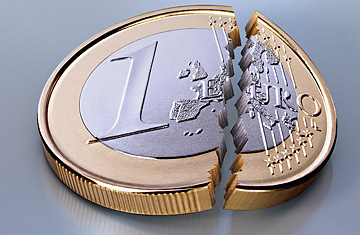
The euro's woes appear to be multiplying ferociously. The markets have been pounding Greece and other weak euro-zone members since the start of the year, while European Union leaders are struggling to contain the crisis. And despite the $1 trillion rescue package that was agreed on earlier this month by the E.U. and the International Monetary Fund for any euro-zone country that runs into financial straits, investors continue to flee the currency. The euro recently hit $1.215, a four-year low against the dollar, and it could go even lower this week. Concerns about the euro zone's banking system, and the May 24 announcement by the Spanish central bank that it's taking over savings bank CajaSur, appeared to push the currency further down on Tuesday. But how serious is the slump, and how big a problem is it for the E.U.?
Certainly, the falling euro is alarming some within the euro zone. Luxembourg's Prime Minister, Jean-Claude Juncker, who leads the group of euro-area finance ministers, is worried about the sharp drop. "I'm a little bit concerned by the rapidness of the euro's slide," he said in Tokyo on May 20. At the same time, European Central Bank head Jean-Claude Trichet attempted to douse the run on the euro, insisting it remained a credible currency. "It's not the euro which is under threat but the fiscal policies of certain countries which must be taken in hand," Trichet said in an interview published on May 21 in the Frankfurter Allgemeine Zeitung daily.
The euro has lost about 16% of its value against the dollar since the beginning of 2010, when it stood at $1.44. Although the $1 trillion rescue deal has alleviated concerns about short-term liquidity issues for Greece, Spain, Portugal and Ireland, many analysts say the euro remains overvalued. Economists at UBS expect the euro to drop to $1.10 by the end of the year, just 10 cents off parity with the greenback. An estimate based on purchasing power parity (PPP), which compares relative buying power, suggests that the euro is 7% overvalued against the dollar at current levels, based on an implied PPP rate of about $1.17.
Should this worry the 16 countries using the currency? "I'm not concerned," says Rolf Langhammer at the Kiel Institute for the World Economy in Germany. "There is no fixed exchange rate between the euro and dollar, no fundamental equilibrium. The ups and downs are normal." Langhammer says the bigger issue is perception: "It is not a weak currency, but people could equate the decline with a confusion in economic policies, triggering more concerns among investors."
Indeed, there are possible upsides to the euro's fall. When a currency declines, imports typically become more expensive and exports become cheaper, lowering the trade deficit and creating jobs. It should make European offerings — be they German automobiles, Italian leather, French wine or even Greek vacations — more affordable, eventually helping the recovery. A low exchange rate could thus offer an effective short-term devaluation and stimulate growth. The Paris-based Organization for Economic Cooperation and Development argues that a 10% fall in the euro translates to 1% additional growth for Europe over a 12-month period, at the relatively modest cost of a little more inflation — about 0.5% to 1%.
"Yes, the overall trend for the euro is down," says Melinda Burgess, a London-based foreign exchange strategist at the Royal Bank of Scotland, who forecasts the euro will dip to $1.16 before the end of the year. "But there is a feeling that Europe is happier with a weaker euro. It can help to offset some of the weak growth and help boost exports."
This may prove crucial not just for a region trying to emerge from recession, but also for the many euro-zone countries that are embarking on painful austerity programs. And it could address a long-standing weakness in the euro zone's most vulnerable, southern members: a lack of export competitiveness. The key will be to develop a wider export base, which means going beyond the euro zone itself.
Conversely, U.S. and Asian exporters will be rattled by the euro's depreciation, as they find one of their biggest overseas markets becoming more expensive. And bearing in mind that the euro zone is one of the world's largest importers — and most commodities are traded in dollars — the plunging euro will mean that Europe faces higher prices for energy imports as well as iPads, Nike trainers and Toyotas.
But in the long term, this should balance out, says Paul De Grauwe, professor of international economics at Leuven University in Belgium. "I don't understand why people say the falling euro is dangerous," he says. "In the 1980s, the dollar dropped by half against the deutschmark in a couple of years. The euro doubled in value against the dollar from September 2001 to 2007. Nobody said this would be the end of the dollar."
Indeed, the 11-year history of the euro shows how much it has already fluctuated. It was about $1.179 when it came into being in 1999, but traded as low as $0.825 in October 2000 before rising to a high of $1.599 in July 2008.
As markets continue to knock the euro around, perhaps this longer perspective should be borne in mind. And if, paradoxically, it makes life easier in the euro zone, then maybe a weaker currency could be part of the solution, rather than the problem.
